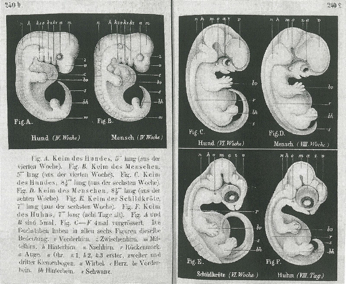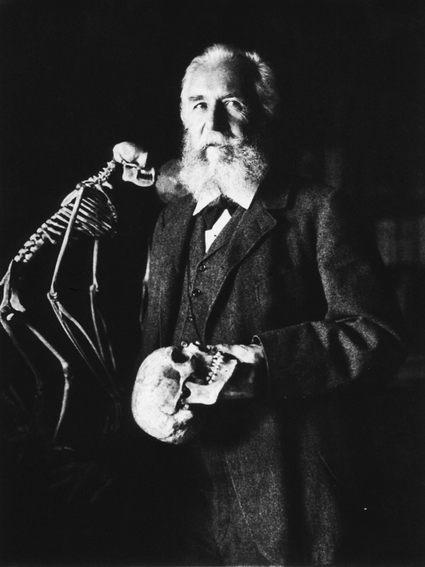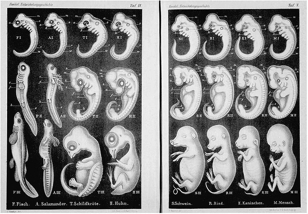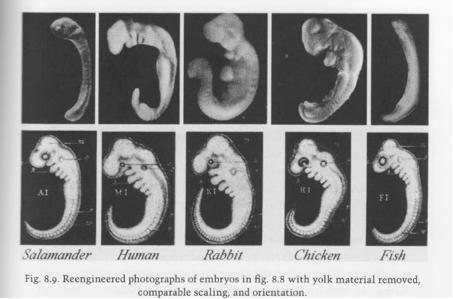
Haeckel came up with a theory that considerably shaped the science of his day. He called his theory the Biogenetic Law, also known under the catchphrase: ‘ontogeny recapitulates phylogeny’. His idea was that the development of the individual embryo, i.e. ontogeny, goes through the same stages as the history of species, i.e. phylogeny. This intricate relationship between the individual and its species would reveal the interconnectedness of all life on earth. Haeckel thought that his theory would prove that evolution actually happens; that common descent of all species is a reality.
You probably have never heard of the Biogenetic Law or obscure terms like ‘ontogeny’ or ‘phylogeny’. However, you are most likely more familiar with this theory than you might think. Probably, you actually came across it in your own high school biology textbooks.
That is because Haeckel did not only come up with the so weirdly sounding formulation of ‘ontogeny recapitulates phylogeny’, he also offered fitting visual support to his claim. And this visual support, his infamous embryo illustrations, is the reason why Haeckel has been labeled a fraud.
This illustration is supposed to show the common descent of dogs and humans. In the fourth week of embryonic development (left picture), the depicted embryos are very similar, nearly undistinguishable. The gill arch, which eventually develops into gills in fishes, is visible in early stages of development among both mammals. Furthermore, both embryos exhibit a ‘tailed stage’. Such rudimentary organs, as gill slits or the tail, remain visible as remnants of morphologies of a species’ phylogenetic past during ontogeny. The conclusion is that man had a tailed ancestor - common descent becomes undeniable. On the right side, we can see how the two embryos slowly divert in the later weeks of development. A certain degree of resemblance, even in these later stages of embryonic development, shows the connectedness of all species in the origin and history of organic life. These illustrations come with a certain rhetorical force. They convincingly show how all life on earth indeed seems to be related.
There was however a problem. Famous contemporary embryologists claimed that Haeckel had actually falsified his illustrations. Instead of using woodcuts from an actual dog and human embryo, they remarked that Haeckel had really only used one woodcut. This was, according to them, fraud and an abuse of Haeckel’s trusting audience (Richards 2008).
Haeckel was quick to respond. He firstly admitted that he had indeed used the same woodcut. He however defended his choice because, according to him, dog and human embryos were indistinguishable in this stage of development anyways. It would not have made a difference had he used two separate woodcuts. He added this explication to the subsequent editions of Natürliche Schöpfungsgeschichte.
Yet, the attacks against Haeckel did not fade in the decades to come. More and more scientists took umbrage at his theory and the concomitant illustrations. Haeckel felt continuously forced to take a stand and justify his illustrations.
His main argument was that his illustrations were schematic, only showing what he considered essential. A practice, as historians of science have shown, that was very common among nineteenth century scientists (Hopwood 2006; Richards 2008). Illustrations in this time were altered to keep the focus on what the scientist considered the most important feature of the depicted embryo. As a result, elements which the scientist perceived to be unnecessary were simply omitted.
Haeckel’s illustrations were thus subjective. They supported his theory that ontogeny recapitulates phylogeny. He picked those elements he considered fruitful visual support for his theory and discarded those that distracted or were unnecessary. In the decades leading to his death, some of his contemporaries continued to label him a fraudulent scientist, while others accepted his illustrations as fitting schemata.
This is however not where the story ends. On the contrary, it had only just begun.
Throughout the twentieth century, Haeckel’s embryo pictures frequented biology textbooks in Europe and the US. If you encountered Haeckel’s work in your biology textbook, it was probably through this lithographs made after Haeckel’s own drawings in his 1874 book Anthropogenie:
Recognize it? In contrast to the previous illustration, Haeckel decided to add more animal embryos. The illustration compares the embryos of eight animals and shows that even fish and birds are almost identical to mammals (including humans) in their early stages of embryonic development (first row).
A 1997 article in Science entitled ‘Haeckel’s Embryos: Fraud Rediscovered’ brought the issue back on the table (Pennisi 1997). The article referred to recent research in which scientists had compared modern photographs of embryos with Haeckel’s illustrations from Anthropogenie (Richardson, Hanken et al. 1997). The results were obvious: Haeckel’s illustrations are simply wrong. Look at the direct comparison between Haeckel’s embryos and the photographs:
The outcry was enormous. Famous evolutionist Stephen J. Gould stated in a 2000 article, fittingly called Abscheulich! (Atrocious!):
"But we do, I think, have the right to be both astonished and ashamed by the century of mindless recycling that has led to the persistence of these drawings in a large number, if not a majority, of modern textbooks!" (Gould 2000)
How could it be that supposedly state-of-the-art science textbooks still incorporate these obviously flawed illustrations? Haeckel seemingly did not deserve a spot in textbooks. He squandered his spot among respectable scientists when he decided to simplify, or falsify, his drawings.
Well, you think this is where the story ends? Nope, it still continues. Let’s take a closer look at the comparison between the ‘real’ photographs and Haeckel’s illustrations. You will notice, especially in the example of the salamander, that the embryo is accompanied by a big ball-like structure in the photograph that is completely missing in Haeckel’s illustration. What you see is the yoke material. Furthermore, some of the embryos are turned differently or have different sizes.
Haeckel admitted that he stylized his embryo illustrations, only showing those elements he considered essential. His aim to portray a schematic depiction of embryos harbors the explanation why the photographs and Haeckel’s embryos are so incredibly different. In his drawings, Haeckel removed the yoke material. Furthermore, he brought all his embryos to a comparable size. Haeckel thus filtered his drawings so that only the, for him, important essence would be visible.
The photographs do not do that. Historian Robert J. Richards therefore proposed to first introduce similar adjustments to the photographs as to have a fairer comparison. Richards thus removed the yolk sacs, proportionally reduced the size of the salamander and uncurled the chicken embryo.
This was the result:
Judge for yourself whether you think Haeckel was a fraud or not. It has to be remarked here that the general idea of Haeckel’s Biogenetic Law is still largely accepted among scientists. Although embryos look not exactly the same or recapitulate all aspects of a species evolutionary past, the main idea of ‘ontogeny recapitulates phylogeny’ has not been proven wrong until today (Richardson and Keuck 2002).
Many questionable website use the story of Haeckel’s embryos to deconstruct Haeckel’s reliability as a scientists and to ultimately raise doubts about the validity of evolution itself. This is one way to look at it. In a future post I will take up the issue of how Creationists continuously foreground Haeckel’s bad reputation as a means to ridicule and badmouth evolutionary theory in general.
For now I would like to draw a different conclusion. I think the story of Haeckel’s embryos is not that much about Haeckel or his Biogenetic Law or even the theory of evolution as such. Instead, it raises important questions about the depiction of ‘truth’ in science and science education. Are stylized images (when described as such) deception? And do photographs always show the objective reality? These are the questions we should discuss. Also think of these questions when you look at Haeckel’s Kunstformen der Natur. Are these images fraudulent, because they are stylized?
Gould, S. J. (2000). "Abscheulich! (Atrocious!)." Natural History 109(2): 42-49.
Hopwood, N. (2006). "Pictures of Evolution and Charges of Fraud. Ernst Haeckel's Embryological Illustrations." Isis 97: 260-301.
Pennisi, E. (1997). "Haeckel's embryos: fraud rediscovered." Science 277(5331): 1435-1435.
Richards, R. J. (2008). The Tragic Sense of Life. Ernst Haeckel and the Struggle over Evolutionary Thought. Chicago, University of Chicago Press.
Richardson, M. K., J. Hanken, et al. (1997). "There is no highly conserved embryonic stage in the vertebrates: implications for current theories of evolution and development." Anatomy and embryology 196(2): 91-106.
Richardson, M. K. and G. Keuck (2002). "Haeckel's ABC of evolution and development." Biological Reviews 77(4): 495-528.



